AllThingsTalk, acquired by distribution company ALSO, has a strategic and pragmatic approach to the Internet of Things that enables organizations, communities and ‘makers’ to rapidly start with IoT projects of any type and size, for makers and professionals alike.
Part of the recipe to make this happen: removing many hurdles for many stakeholders – with an indirect model and accessibility taking center stage. We had a long conversation with AllThingsTalk CEO Tom Casaer who explains how to make IoT projects effectively happen – and much more.
Tom also takes us through a variety of important topics and challenges in the IoT industry – with ample takeaways for companies with IoT project plans and ecosystem players.
Today, most IoT projects don’t get realized because the costs of very reliable data streams is really high (Tom Casaer, CEO AllThingsTalk)
To name a few: the challenges of operators to make money with cellular LPWAN technologies such as NB-IoT or LTE-M (types of wireless IoT communication technologies) the fact that most IoT solutions today are monolithic closed systems, how IoT platforms are necessary but require a lot of work and resources (and thus money), why getting started with IoT projects matters and the current lack of real triggers for companies to invest more in IoT projects and solutions. In other words: a bunch of insights.
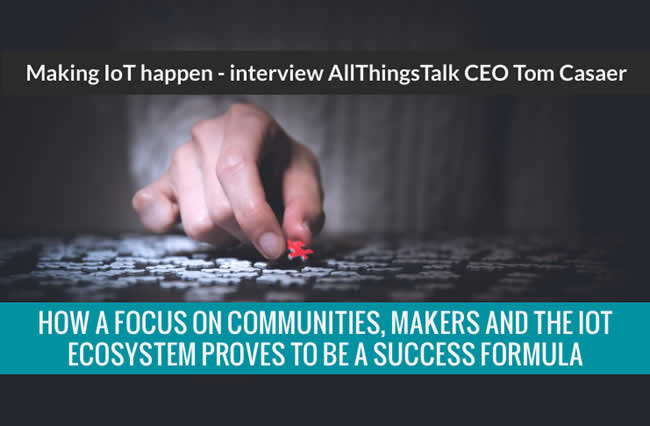
Many game-changing IoT players don’t exist yet
The growing adoption of IoT and rise of IoT projects has gone hand in hand with a broadening landscape of businesses that are active in (a segment) of the market.
Organizations selling databases of various IoT firms across different segments typically list way over 1,500 players and that is still far from a complete oversight. Add the companies who are active in the related area of Industry 4.0 – or Industrial IoT – and the picture becomes even more overwhelming.
Yet, according to Tom Casaer of AllThingsTalk it’s far from over yet. In fact, he says that many of the game-changing IoT players don’t even exist today he says.
Between the time this interview was conducted and published we saw some (potential/likely) game-changers enter the market. Here’s the thing: while one could be led to believe IoT is already mainstream for companies, it isn’t and despite all the progress it still, indeed, remains relatively early days in more than one area as you’ll read. To understand the context and, in a way also to remind several aspects of what IoT projects need, we start with an overview of what AllThingsTalk does and has done. Some activities, partnerships and projects of the company are further used to illustrate evolutions and insights.
Removing IoT complexity with a community-oriented middleware
Tom, thanks for granting us some time. Could you first introduce yourself and AllThingsTalk?
Tom Casaer: AllThingsTalk was founded in 2013 with a vision of making IoT technologies accessible to anyone. We’re a Belgian company with offices in Ghent and a development team in Belgrade (Serbia) where one of the co-founders heads up the development.
Since IoT is a fairly complex matter and we want to make it accessible, we saw there was room for an IoT middleware to serve the mid-market and the maker and developer community, enabling them to get quickly started with a variety of devices and networks. We built the middleware that runs in the cloud as a product platform-as-a-service and offer it as a service, along with professional services, to B2B and community organizations.
Companies that are playing with IoT discover entirely new use cases they never thought about before in almost 100% of the cases
It enables users to connect any device through hardware or software gateways across a multitude of networks whereby, since the beginning, we strongly focused on the new wireless IoT networks (editor’s note: LPWAN), which several operators launched, mainly LoRa, narrowband-IoT (NB-IoT), Sigfox and LTE-M.
Starting with this dimension of connectivity management, we built various services to make the data streams from different sources usable as one managed stream: collecting and aggregating data, normalizing data and standardizing it.
Next, we allow people to utilize this data by offering quick tools in our platform, on top of our API. For many IoT use cases, and especially for prototyping MVPs (minimum viable products/projects) and small-scale deployments, the user interface to do this offers what they need with very fast visualization; self-service business intelligence, user management and device management, on top of this data aggregation layer.
Finally, we enable people to use and share this data, either by using some of the quick tools we developed or by working in communities around certain data sets.
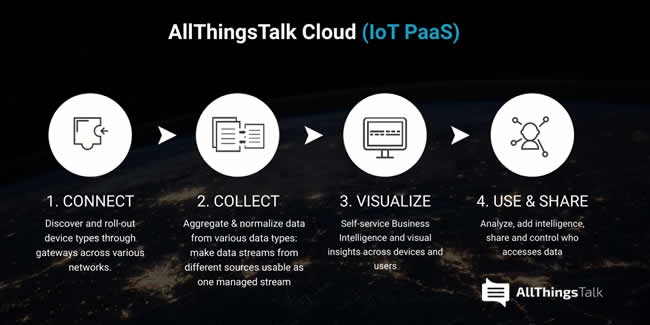
Our model is purely indirect. We have all types of partners across the whole value chain such as:
- Partners on the hardware level with whom we work to create templates for their hardware, so it’s easy to automatically roll it out in the AllThingsTalk platform.
- Connectivity partners, which are mainly those several LPWAN partners (note: such as various communication service partners and network service partners, more below).
- The integration and solution partners who build solutions on top of AllThingsTalk and are an important part of our focus.
- Smart grid partners who have all kinds of challenges in the decentralization of energy production and transport.
- Citizens and citizen/maker communities whereby we developed all types of community features to allow them to organize themselves and create a powerful force to influence politicians or industries, out of sensor data.
Focus on low power wide area networks: deep integrations with non-cellular ecosystems
The first LPWAN networks in Belgium and The Netherlands were non-cellular LPWAN networks whereby KPN rolled out the first ever nationwide LoRaWAN network in The Netherlands, followed by operator Proximus who did the same in Belgium. That’s where it started for AllThingsTalk. Can you tell us how that evolved and what partnerships you have there?
Tom Casaer: Sure. We indeed started connecting the first LPWAN networks in Belgium, the LoRa network of Proximus, over 5 years ago.
We worked very closely with Proximus and developed a rapid development kit for them. We also developed the application layer to containerize the traffic from the sensor to the cloud platform, so that we could roll out this whole rapid development kit and all its assets with one click, making it easy for people to discover the possibilities of this network.
This got picked up by many other players in this area and now we have deep integration – so not just HTTP but bidirectional message plus integration over MQTT – with players like Everynet, in the testbed in London and the UK, run by Digital Catapult and British Telecom (‘Things Connected’).
The challenge operators have with NB-IoT and LTE-M networks is the average revenue per user
We also have deeply integrated with Actility, the backend provider of most public LoRa providers in Europe such as Proximus, KPN, Swisscom, LATTelecom (Latvia). Next there are players who built a LoRa network service in the cloud that allows companies to build their own private LoRa network. The main players in Europe are LORIOT in Switzerland and Everynet with which we also have very deep native integration.
Last but not least, there is a community-based LoRa network, The Things Network (TTN), originating from the Netherlands (editor’s note: TTN’s open IoT network is growing fast with more than 7,000 gateways in well over 120 countries and, as announced on its 2019 conference, expanding into China with Tencent). The deep backend integration we have with The Things Network basically allows you to roll out a device over TTN with one or two clicks.
Moving into NB-IoT and LTE-M – and towards becoming an MVNE
And then came the first networks with LPWAN standards in the licensed spectrum as we know them from 3GPP’s release 12 and 13 which are being rolled out globally, again with Belgium and The Netherlands being fairly early movers.
Tom Casaer: From LoRa (unlicensed spectrum), we indeed moved onto the new IoT networks that popped up in the licensed spectrum: NB-IoT and LTE-M.
In the Benelux we first started working with T-Mobile in the Netherlands and with Orange in Belgium. We deeply integrated with them and have a far-reaching go-to-market alliance with some such as Orange in Belgium and more recently also with Vodafone, together with SODAQ (editor’s note: more below and in the video at the bottom of this post).
Here as well, allowing the market to explore the possibilities of the networks these Communications Service Providers offer in a much faster way, is key. The operators we work with are slowly moving from narrowband-IoT towards LTE-M and most likely the two networks will exist in parallel because they serve different needs.
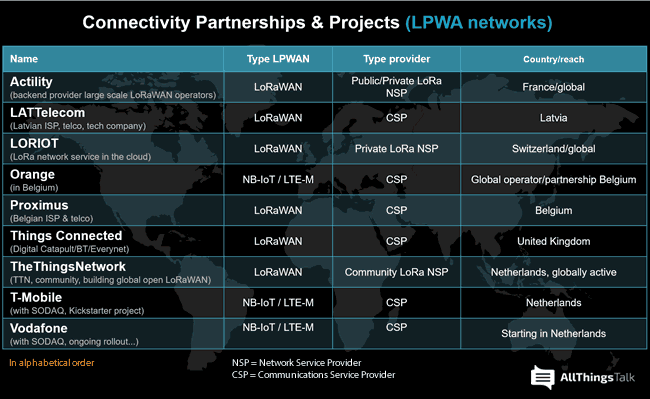
What did you do with T-Mobile?
Tom Casaer: At Mobile World Congress 2017 we had a showcase that garnered quite some attention. SODAQ, who was our first hardware partner, powering the boards in our rapid development kits and sharing our vision that power efficiency is critical in everything we do, had created one of the first NB-IoT shields for developers across the globe (editor’s note: an NB-IoT Arduino shield).
In that year T-Mobile had finalized the first NB-IoT network with national coverage in the world, namely in The Netherlands. Together with them we created a Kickstarter campaign, essentially enabling people to acquire these boards before U-Blox put them on the market through this SODAQ crowdsourcing campaign, supported by T-Mobile.
The true value of IoT is in creating compound IoT applications – today very few platforms or technology players enable that
They were the first devices worldwide that allowed people to test NB-IoT. The campaign succeeded and with AllThingsTalk Maker, our developer and maker platform, people could simply click to connect a device, trigger the device template, select the network service provider (T-Mobile) and get the pre-configured application for the device rolled out.
Essentially, it was a five second onboarding, including the connectivity. Now, this also meant that we were moving towards becoming an MVNE (mobile virtual network enabler) for IoT devices because from within the AllThingsTalk Maker platform you can include the connectivity in the device.
The showcase received quite some attention and we went a lot further with Orange.
You’ve mentioned SODAQ a few times now. You’ve worked with them on the T-Mobile KickStarter campaign and now they work with you for Vodafone (video at the bottom of this post). Can you tell us who they are and why you seem to find each other?
Tom Casaer: Sure, so as mentioned SODAQ was our first hardware partner, powering the boards in our rapid development kits. They share our vision that power efficiency is critical in everything we do.
From day one, we have put a very big effort on power efficiency because many of the tools we develop indirectly have a huge effect on power efficiency of the battery.
Everything we do needs to be thought through deeply from a point of view of power efficiency.
We, for instance, developed tools to reduce payload being sent between the device and cloud. But we also have all kinds of tools to make sure that you need less traffic between the device and the cloud. And SODAQ, which is an acronym for solar-powered data acquisition, is a group of engineers who have been working for decades with global NGOs implementing electronics in Africa, in Asia and in less developed areas. They have extreme experience with low power and that’s why we are working so well together because we both share the same vision that everything we do needs to be thought through deeply from a point of view of power efficiency.
The technological, business and operational capabilities operators need
Clear. Back to Orange Belgium that finalized LTE-M and NB-IoT coverage in Belgium in 2018 when we first wrote about AllThingsTalk.
Tom Casaer: So, Orange liked what we had done with LoRa and with the T-Mobile project. They wanted to combine both approaches and even go much further.
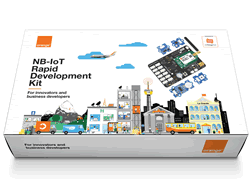
We developed a fully branded version of AllThingsTalk Maker, an Orange NB-IoT and, more importantly, extremely detailed and documented guidance for experiments to make sure that any user, technical or not, would be able to have an end-to-end application running in less than 30 minutes.
To make this possible, the SIM card is already pre-provisioned in the kit and we enable people to order new subscriptions through the market place.
To summarize, we developed the page for Orange explaining the project, the kit, a white label prototyping version, the connectivity offers and a dedicated shop where all products are available, and customers can buy the SIM cards.
On top of that, we also distribute the SIM cards for Orange.
So, you’re almost an end-to-end fulfillment partner here?
Tom Casaer: Yes. Now, you might wonder why we distribute the SIM cards. As you know I have an MVNE background, having previously worked at Belgian MVNE Artilium.
The challenge operators have with Narrowband-IoT and LTE-M networks is the average revenue per user (ARPU). In the M2M world ARPU is probably still roundabout 100 to 200 euro per year.
However, with NB-IoT, ARPU goes down to perhaps 8, 10, 12 or 18 euros per year, a reduction of 80 to 90%. So, the distribution of the SIM cards through existing channels becomes a serious challenge for operators.
That is why we take this pain away from them and help them in this first phase. In a later phase we are going to bundle the connectivity plans with the services of the IoT platform, which makes it much easier for users to build end to end solutions rapidly.
Creating reach across the right communities
Earlier you mentioned the different types of partners AllThingsTalk works with, the importance of integrators, communities and so forth. You just explained how you work with operators in a close collaboration. How does it all connect in your view and business strategy?
Tom Casaer: The partnerships provide us with reach towards makers and developers. Many of these people are also enterprise developers who just play around with our platform – and the tools we developed on top of it – in their free time and then take the technology to their businesses.
Our go-to-market approach really starts there; always by meeting the needs of certain communities of people who share the same interests and by making sure IoT is accessible for them. An example I mentioned is the community of developers who are looking to start testing the new IoT networks.
Moreover, the tools we develop to support a community of users can serve other types of communities, whereby we each time have this community-as-a-service offering approach. For our commercial partners this is of course important because they need various things enabling them to build out their business offerings in a cost-effective way.
So, creating reach is essential and we do it on a large scale through our indirect model. Recently we announced a partnership with one of the largest distributors of electronics in the world, Electrocomponents, the company behind RS Components and Allied Electronics & Automation, that launched a new company, OKdo, that focuses on single board computing and IoT. We power the OKdo cloud and that gives us additional reach to close to a million developers worldwide.
Through seeding the market with our free Maker platform across various partnerships we pick up the business users of the platform with two specific offerings.
A first group of users we address is that of people developing their own hardware solutions and devices.
They usually don’t have the money to market their products and bring them to users. The community partners, the telecom companies and distributors who pay often encounter the challenge that they don’t have the hardware. So, essentially, we try to match both these groups through the market place.
Vodafone is an example of this. While launching their new NB-IoT networks they build a catalog of devices which have a template for automated roll-out on the AllThingsTalk platform. So, this is really matchmaking between small hardware device makers and large network players who need devices and applications.
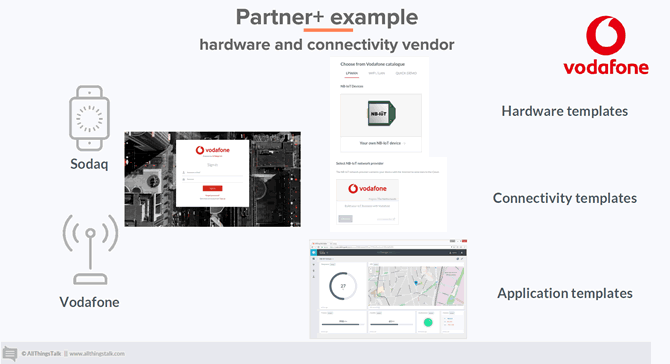
A second group where we have another type of offering to try to pick up from our broad market seeing efforts are integration partners, solution partners or essentially everyone who wants to start with an IoT platform under their own name.
For them we offer AllThingsTalk Spaces, a paying version of our platform as an application container allowing people to isolate their own users, their own devices, their own data sharing under their brand and look and feel.
We have several customers from across different industries and verticals here.
- Minimax, a German industrial player, using the platform to optimize the usage of their sprinkler systems with predictive maintenance; reducing the monthly time to test the systems, which is a significant cost in every installation they have worldwide.
- Automatic Systems, a big Belgian-French player in barriers and access systems. They use their own application container for product development, to make their products smarter and coming up with new use cases for their access systems.
- In the field of smart metering we have, for instance, Infrax (editor’s note: multi-utility firm Fluvius, which serves the Flemish market). The challenge with many energy and grid players is that they need to connect a multitude of meters and normalize the data. In our Partner+ offering we have a standard feature, enabling to create templates or device types, each of them having their own device template which makes it very easy to automatically recognize different meters and roll out large numbers of them in an automated way.
- The Port of Antwerp, where a lot of innovation is going on, is another one of our reference customers. They also have the challenge of aggregating data from many vendors throughout the port who all deliver their monolithic solutions. The interest of large organizations such as Port of Antwerp and really all large industrial organizations is how to make sure they capture the metadata across all those monolithic solutions. One way of doing it is tapping the data at a very low level a second time, just to bring it into one big data lake and to discover anomalies and patterns in the data across different sensor vendors. So, this is a typical data aggregation story.
- There are also several research institutes and universities using our platform. Several use the free version, but we see more and more starting to use the paid version, whereby master students develop all their new IoT related projects on our platform.
- And then we have quite some experience in the air quality related smart citizen area where we started with a project in the city of Aalst and are planning a large project that will be worth watching. That smart citizen approach, as said earlier, is also key in our approach.
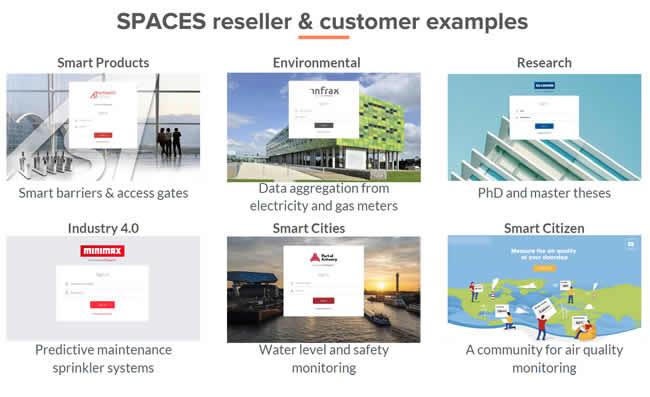
Filling the gaps: large IoT clouds aren’t ready to address the needs of channel partners
The focus on making IoT accessible for everyone, building reach, offering additional tools for business users and solving the pain points of different actors works for AllThingsTalk. How would you say this compares to the evolutions in the crowded IoT platform market and the IoT market in general?
Tom Casaer: There are many high-end systems out there, but the thing is people have to do everything themselves. The big cloud platforms from US players like Microsoft, Google and Amazon aren’t ready for the small and medium enterprise market and still require high-level technical skills.
When people talk about IoT they often really talk about the incredible things you can do with all that data and everyone is convinced that the real value is in using and sharing this data and in putting at work. In other words, looking back at our ‘Connect -> Collect -> Visualize -> Use & Share’ approach it’s clear that the value is on the right-hand side.
However, where are the costs still highest? Indeed, on the left-hand side. And that is the problem in reality today. The consequence? Most ideas don’t get realized because the costs of getting very reliable data streams is really high. So, this is an area where we strongly believe there is room for a middleware product like ours and why we have these different partners trusting it.
Most research also points into that direction. In the Summer of 2018, at the occasion of the worldwide survey it conducts every two years, Bain & Company said that, although there is an incredible belief in the potential of IoT – which is the biggest ICT wave ever – very little progress has been made regarding security, integration into existing environments and costs/ROI. It is all still way too expensive and we’re trying to remove some of those barriers.
Bain & Company also pointed out what we believed since the beginning: the large IoT clouds aren’t easy and affordable enough for channel partners – there aren’t cost-effective and ready-to-use IoT platform solutions available to channel partners today.
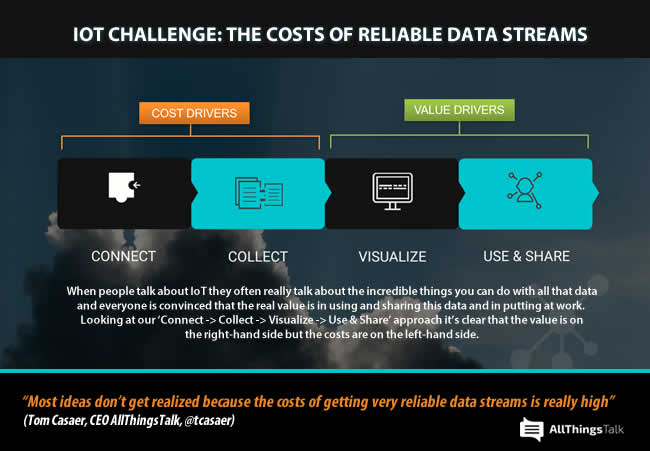
Industrial challenges: from closed systems to the need for speed
When we briefly talked about Industry 4.0 once before this interview you said that quite some industrial IoT implementations existing today might need to be reconsidered. Can you tell why?
Tom Casaer: It has to do with the openness of the system. If you build something in a monolithic way it might work today. However, the true value of IoT comes from combining certain data streams in real time with other data streams and you need open systems allowing you to do that.
And that’s a challenge in the market today. It’s even the reason why many companies aren’t investing too much in IoT yet because they of course see this is well.
If you have a company that makes industrial factory gates, you know that one day the system will have to ‘talk’ to the ERP system, the CRM system, etc. The system may also have to ‘talk’ to the cars and/or trucks driving through the gate. It might need to talk with suppliers of components so that a predictive maintenance alert can be sent, and the parts can be ordered in time.
Whatever the scenarios and purpose in the end is, it’s clear that doing all this isn’t that easy. However, the true value is precisely in creating these compound IoT applications and today very few platforms or technology players offer this very broad array of possibilities to combine different IoT things.
That’s why our vision is one of an open system. We could in theory connect any network and any hardware. We just need to make an SDK (editors’ note: Software Development Kit) for it. And we’re constantly adding more and more connectors on that level. On the application level, of course we have the API, but we could go much further in having pre-configured API integrations with whatever environment or system: SAP, Salesforce, Oracle, you name it. Once we find the customer case it’s just a matter of building the connector.
Talking about Industrial IoT and Industry 4.0: IoT technologies don’t stand on their own and in larger projects often require more. There’s AI and machine learning, edge and fog computing, distributed ledger technology, you name it. Your focus is on SMEs and communities. Yet, do you see specific technologies and architectures play a bigger role today in some areas – and to what extent can you support such projects?
Tom Casaer: We definitely see the importance of other technologies. By way of an example: we recently had a case where a very large global industrial player realized that they could build up their own real-time visualization of the device data of a CNC machine.
They built it themselves in less than two hours using the AllThingsTalk platform. Of course, these companies work with the likes of, for instance, Bosch and Siemens, to tackle their large production systems. But this is so big and so all-encompassing that nothing tangibly happens in the short term and they also like to have some quick results in the short term.
In fact, we have many industrial customers who just want to get stuff done and if it is just for internal use they care less about some aspects. We definitely see many industrial companies buying the Swiss knife of IoT of AllThingsTalk to get some stuff done quickly.
The serendipity factor of trialing with IoT is extremely high and that’s why we believe literally every company should be starting with IoT today
So, that’s a digital twin project you’re talking about here?
Tom Casaer: Precisely. They were able to do it with AllThingsTalk and the tools that they already had in house.
And they can build it in a digital twin of their CNC machine when it stops, when it’s running, when it’s pausing, when there’s errors in real time, and they said that it’s been literally less than two hours. That’s pretty cool, and it costs them 249 per month for the platform, and if they want to get more SLA then it costs them 599 a month. It’s a no-brainer for the big industrial companies, and we definitely will sell there a lot of well.
The channel is key – as is getting started with IoT
Just as it’s important to build open systems on the technological level your indirect model is an open one on the business level with an indirect channel approach whereby you’re recommending businesses to start with IoT now and are putting everything in place to allow them to. It’s of course good for your business but why do you think this is important.
Tom Casaer: The channel approach is, among others, a result of our belief that the ability to offer the customer an end-to-end turnkey IoT offering WITHOUT changing their current buying habits is a challenge in the market that needed to be addressed.
End customers in the SME market typically buy from their system integrator or their local trusted advisor in general so these are the people we need to enable: the application builders, the local SMEs who provide solutions. So, we indeed believe that the channel is key for the success of IoT, the reason why we developed this entire platform specifically for indirect channel partners.
It reflects across our different solutions: the mentioned platforms and tools, the hardware kits, the Partner+ program to enable partners to roll out their own hardware quicker. On the network side we enable our connectivity partners to run their own developer community as we do for Orange – and more are coming.
And then there is the channel version of the platform, AllThingsTalk Spaces. Now, to make channel partners succeed and let people and businesses start with IoT in an accessible way this platform needed to be very cost-efficient. That’s why the pricing of Spaces, which is really a full-blown IoT platform, starts already at 249 per month.
So, there is no reason for companies not to start doing something with IoT today and we indeed believe that doing nothing is not an option.
One of the reasons why getting started matters: companies who are playing with IoT discover entirely new use cases they never thought before in almost 100% of the cases. So, the serendipity factor of trialing with IoT is extremely high and that’s why we believe literally every company should be starting with IoT today – and we have an offering for them to do that.
We believe that our role in all of this is the enablement of applications. We’ve built a few ourselves. Yet, our goal is not to become a systems integrator but to offer the market the tools to do it themselves.
An example of an application we built is for assisted living whereby we believe it can be built 10 times quicker and 10 times cheaper than what is on the market today.
That’s also what some of our customers understand as they develop applications on top of our platforms. A nice example is Ikanda, a small integrator in the smart signage field who uses our platform to connect our hardware partners and their sensors to software from a Dutch software company Flexware.
They tie it all together as a system integrator and have already won some very big clients such as KPMG and the European Commission with this simple solution. They are hiring very fast, so they can really build a lot of intellectual property and services on top of the AllThingsTalk platform. We believe this is the way to go. In fact, you could compare it with the model Navision had at the time.
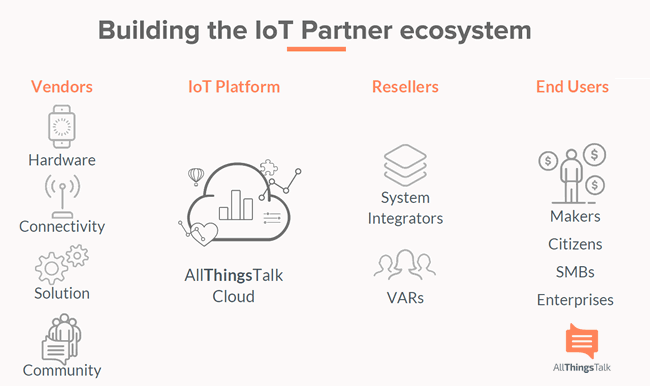
And the technical tools and security to enable all that?
Tom Casaer: Everything we do is based on API, both internally and externally so there’s no other way to talk to the platform than through API. We take this very seriously and of course we also take security very seriously.
There’s a highly detailed white paper on how we deal with confidentiality, integrity and availability of data and giving an overview of the kind of tools we have, to prevent discover and repair breaches.
It also explains how these different methods overlap horizontally and vertically and how that enables us to tailor the security approach to the individual use case.
This is important because risk containment really means that you have to apply a high security where it matters most and a decent managed security where this is less needed. Cost is an important factor here but, to give an example, there is also little sense in having full blown security for measuring the level of waste bins.
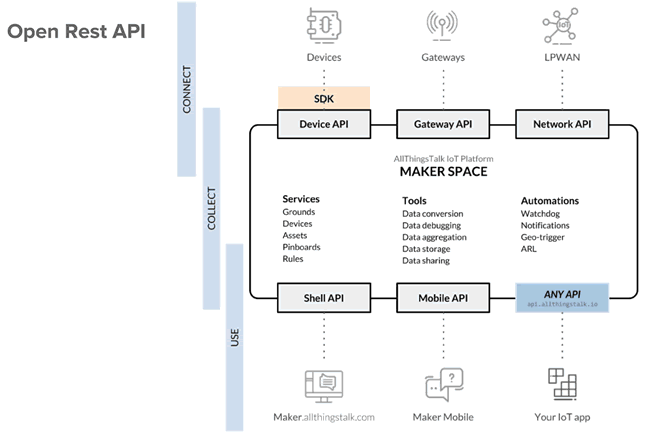
A WordPress for IoT
Your channel-oriented approach whereby you look at what doesn’t work in IoT today and make it work for various stakeholders has enable AllThingsTalk to grow. Do you see the fact that you’re a Belgian company and thus started in a small country as a driver of your thinking out of the box, is it more in the DNA of your company and the choice to focus more on SMEs, the so-called makers and communities or is it more because you rethink those things that don’t work?
Tom Casaer: It’s a mix of everything. Belgian companies indeed need to think very hard how they can serve the world market because their home market is very small, and they need to be extremely creative with money because the access to it is not the same as in the big countries.
Luckily the level of education and innovation in Belgium is extremely high allowing us to be always one step ahead. At the same time, it’s true that we deliberately try not to go where the others are going because we have limited resources.
We need to find niches that others are not taking and then I’m especially talking about the big players I mentioned before. They have no choice than to focus on the big use cases first and only later, perhaps in five to ten years, they will start building middleware for the mid-market.
Today they build building blocks which they need to make extremely robust to support millions of sensors in a single use case or with a single customer. But the reality in the market is that any company today could make use of IoT. They just don’t have the resources to do it themselves and we want to help them with that. So, in certain way we’re building a WordPress for IoT and we believe there is definitely a market for it.
The importance and evolutions of LPWAN
You started early on with the proprietary standards and now also work with cellular IoT networks in the sphere of low power wide area networks or LPWAN. For many LPWAN is still relatively new as some of the main non-cellular players started in Europe. What is your view on the evolutions in the LPWAN market and the various actors?
Tom Casaer: For many the importance of LPWAN overall might indeed not be so clear yet today but that will change rapidly.
The reason is that the number of use cases grows exponentially if the lifetime of a battery goes up. If, for example, I can make a sensor that is small enough and a battery that lasts long enough to put it in a simple window glass then that sensor can tell me whether the glass is broken or not. At the moment the cost to achieve this is low enough companies will start doing this because they can make money on an event-based business model where people would be willing to buy notifications from windows that are broken.
It’s perhaps an extreme example and not the best possible but it illustrates my point. The ROI of an IoT use case mainly depends on the service cost, not on the hardware or connectivity cost. The cost to service a solution means man hours, the rest doesn’t.
The number of use cases grows exponentially if the lifetime of a battery goes up
Let’s take an existing example. If you create a trap for rats like people are doing in the Netherlands to protect the dykes, the main cost is replacing elements of the hardware and especially the battery. If the battery can last a few years longer the ROI of the whole business case changes dramatically and that’s what LPWAN does. It dramatically reduces the lifetime of the battery making much more use cases ROI-positive.
Analysts, who are looking at this from all angles, predict that around 40 to 50% of all IoT sensors in the world in five to ten years will be powered by LPWAN technologies. Many sensors will be wired, many sensors will be LPWAN and the remaining part will probably be energy-harvesting and hopefully this part grows quickly as well.
Now what’s the difference between the standards in the public licensed spectrum and those in the unlicensed spectrum? The unlicensed spectrum for the moment is nice to have in public networks. However, soon as more and more gateways will appear, the noise levels will rise in those frequency bands and the public networks will have to start transmitting more and more power with the result that the battery life will go down. Especially Sigfox has a very big challenge there.
I have to say I personally don’t believe that much in public networks using unlicensed spectrum. However, I do believe a lot in private networks using unlicensed spectrum. Any organization with a big footprint – whether it’s a big plant, a factory or an organization which has many different buildings in a country such as elderly care organizations or municipalities – can easily set up their own antennas. It’s quite cheap for them to create their own – private – LoRa network and they don’t have to pay the public operators. So, in those scenarios, we see LoRa being very successful today and Sigfox as well because, although positioned as a public network, you could say that Sigfox is in fact one big private network.
Another area where I see many opportunities are the community-based networks where people set up very cheap base stations themselves, a bit like Fon did in the WiFi landscape. The growth of The Things Network is amazing with already over 7,000 base stations put up by people. It only costs a few hundred euros to put one up and you can take advantage of the global TTN network or the community network which is very powerful. Especially in cities like Amsterdam and Berlin, to name a few, it’s really mind-blowing how many base stations have already been set up by the community.
We love what they do, they love what we do and we’re quite complementary in our vision, even if of course we all need to build our own business.
The ‘real’ IoT – where are we?
Where would you say we are now with IoT? Early days and only really starting?
Tom Casaer: Yes and no. It is definitely starting. I would call the phase we’re in now the ‘smart products’ phase. It’s not really IoT products yet but the predecessor of IoT products. Smart products in my terminology are rather close and monolithic. Of course, they use cloud services and maybe sensors and mobile apps and we all believe it’s IoT but they are in fact monolithic solutions.
The real IoT products will only come gradually when a certain product will be open enough for others to connect with it and create compound applications across verticals and segments. We probably won’t notice when we enter this new face.
Certain areas are already further developed. I strongly believe in IoT infrastructure-as-a-service and once the private market has the capability to put IoT infrastructure in, for example a smart city, and make it possible for the market to develop applications on top of it, then the real power of IoT will come into play. It really doesn’t help if every city builds their own monolithic small solutions.
We need that infrastructure, just like we have fiber, water, gas and electricity: an infrastructure backbone for IoT, preferably not owned by governments and open enough for the market to build applications upon.
We’re still a few years away from that although we do see the first signs of private consortia starting to build this infrastructure. One of the first areas probably is city lightning which can help provide a backbone for IoT.
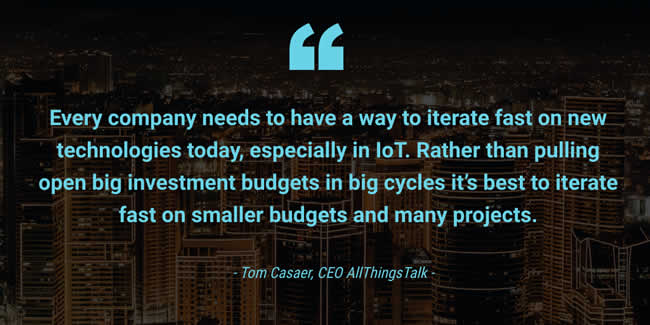
Why getting started and iterating on small budgets matters
Although your focus is on SMEs, makers, integrators and communities, on top of operators and some larger channel partners, a lot of what you’re saying goes for larger enterprises too. Test, try, learn, do a pilot, discover by doing, launch, iterate, work in an incremental way, etc. What’s your take on those larger organizations where now and then projects also start in a rather small way or even with some people simply trying things out as customers tell us?
Tom Casaer: Here as well I indeed think it’s important to start. If you wait until someone comes with the perfect use case, it’s as if you’re waiting for the chicken with the golden eggs.
It will probably never come. A reason why it matters to get started is that companies which are using IoT technology in their product development, iterate at a pace six to seven times faster than companies that don’t.
After one, two, three years you are literally dozens of iterations behind. It might not seem long – one or two years – but in today’s world it’s extremely long and the number of iterations count more than the time. If your competitor is five or six product iterations further than you or can iterate much faster than you, you will probably go out of the market.
I believe that’s also the advice McKinsey gives: rather than pulling open big investment budgets in big cycles it’s best to iterate fast on smaller budgets and many projects, and then see what works.
Only increase the investment level once you figure out something that really works. I think that every company needs to have a way to iterate fast on new technologies today, especially in IoT.
The importance of the maker movement: Bring Your Own Device – including sensors
The importance of ecosystems is well-known. We talked about it, we see larger organizations building out their own or collaborating with small startups etc. Then there is also the so-called maker community that started quite some time ago, is very active and even has changed a bit with large organizations of course also looking at that ‘movement’. Why is this maker movement or community so important for you?
Tom Casaer: There are two reasons why we focus so much on the maker. One is because a lot of innovation is expected to come out of this long tail of makers and developers.
Many analysts also predict that a lot of new IoT solutions in five years from now will come from companies that don’t even exist yet.
The second reason is that the whole maker movement is growing rapidly worldwide. This isn’t a consumer phenomenon but a mix of professionals who like to play in their spare time and that has an impact on the businesses where they work.
In fact, many of our enterprise customers started on our Maker platform using their Gmail or Hotmail account. They played around, they bought one of our kits when they downloaded the software development kit, they liked what they saw, and they’ve brought this technology to their company.
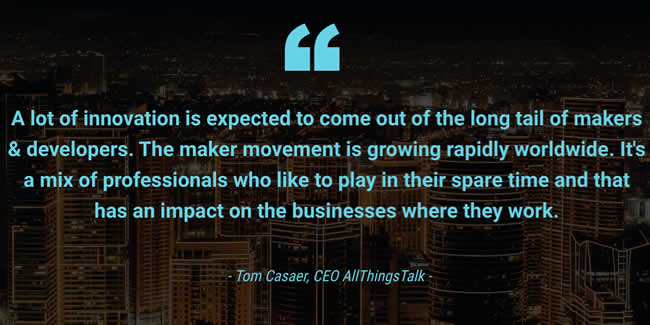
And do they start from wanting to solve a problem or is it more playing around for other reasons?
Tom Casaer: It’s a mix. It can start from a problem, it can also start from curiosity and just playing around, and then seeing the possibilities of the technology, realizing that they can bring this technology to work.
After ‘Bring Your Own Device’ as we know it, we are now giving a new meaning to BYOD. It’s no longer about the mobile phone, it’s also going to be about the sensor.
People who are 15 and older today are very technology-savvy, and a growing number of them just wants to build things themselves. It’s not just on the developer side: there’s a lot more happening in the DIY and maker space, including on the hardware side, which basically didn’t exist a few years ago. Who was active in building their own electronics before? Today, however, this is a fast-moving community, and we strongly believe in helping that community realize what they want to achieve.
The IoT market from a geographical perspective
You’re doing business in different countries, had the T-Mobile and SODAQ NB-IoT project at Mobile World Congress 2017, stay updated on global IoT evolutions and travel around to attend other events and speak with colleagues. What’s your take on IoT in different countries, perhaps starting with Europe?
Tom Casaer: Recently I was in Berlin for a week, meeting people from the local IoT ecosystem, along with other Belgian IoT companies.
I was really impressed by how far the industrial IoT ecosystem has evolved in the city. There are close to 6,000 startups in Berlin, many of them focusing on IIoT. The whole ecosystem around it, the capital system around it and the way they match the startups with the industry is very, very impressive.
My personal impression is that the industrial IoT headquarters will be in Germany for the next few years, in Berlin. On the front of IoT applications and analytics, I think there is still a very strong ecosystem in France and Belgium. Regarding the UK, it’s a bit harder to see but they are financially very strong so they can basically catch up quickly on whatever happens in the world.
The Netherlands and the Nordics are quite pragmatic and that’s where we see most adoption, especially in the non-industrial IoT. In Belgium we probably do things a little bit slower but more thought through, with a longer term-vision, and with less focus on the short-term profitability as really is always the case.
We’ve been speaking about those smart waste bins for the last ten years but I still don’t see them, until recently, I believe it was Telenor, who announced that they’re rolling out smart waste bins on narrowband-IoT across the major cities.
We’re starting to get there but, yes, for me Norway, Finland, Sweden and, next, The Netherlands are probably the most advanced markets in terms of adoption in that non-industrial area and I will be very surprised if the world center of IIoT will not become Berlin – or at least Germany, they’ve put big bets on it.
Globally, I believe that there are three main centers with the hardware center being Shenzhen, the Industrial IoT center being Berlin/Germany and the West Coast of the US having the strongest consumer IoT ecosystem.
Yet, IoT is big enough to have smaller ecosystems be very successful as well. I don’t think Belgium has a problem: just as we have done with biotechnology and nanotechnology I feel focusing and clustering will definitely help us in finding our own niche and claim world leadership in that niche in IoT.
Governments, local, national and supra-national play a role in IoT and other technologies. It can be projects, regulations, programs in the scope of some digital agenda etc. What is the role of governments in your view?
Tom Casaer: For me, the government’s role ideally is to accelerate the growth of the ecosystem, but preferentially not trying to be a cornerstone in the ecosystem.
They need to enable the ecosystem instead of trying to control it. That seems to work well in most European countries. Let’s be honest: there are many smart city deployments that are just temporary solutions. Cities throw money at them but in a few years nothing will be left since in reality a monolithic closed system has been built.
It’s fine to support a local ecosystem for now but the government needs to focus on IoT as an infrastructure and enable that. That’s my conviction, and luckily the first signs of that can be seen already today as well.
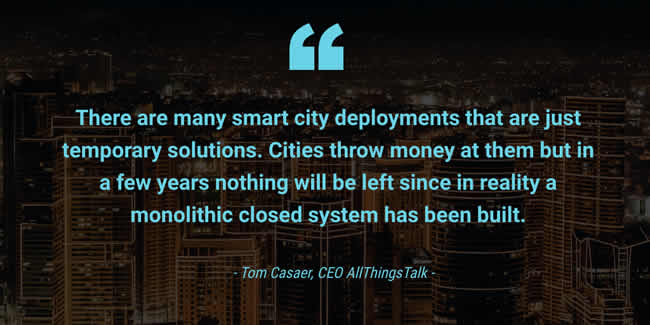
What IoT and cloud have in common: incremental patterns
You’ve touched upon the state and changes ahead in the market before but what do you see for the future, as evolutions and as triggers that will drive the market and adoption of IoT?
Tom Casaer: The IoT market was pretty much in a standstill phase until 2017. In 2018, we’ve seen quite a change whereby the market is starting to realize that they need to get their hands on IoT and get started doing something. That’s a big change.
We didn’t lose any proposals in the past or almost none. They were just often stalled, and people were waiting, waiting, waiting. This is changing now, and I think the big change will come when, of course, we’re crossing the chasm. The question is when that will happen and, probably, it’s when the first real use cases start to be visible for the mass market. If governments successfully roll out some of those smart city solutions, people will start thinking, “Hey, what does this mean for me and my business?”
The general adoption of sensor technology is also changing. Probably there needs to be some kind of a GDPR for sensors, which might be a breakthrough moment in the market. But just as was the case with cloud, it’s hard to predict.
I mean: when did cloud computing start breaking through? I am working on it since 1998, the term cloud was invented somewhere around 2005 and after that it gradually became more or less understandable for the mass market what the concept of cloud was all about. However, even today, only about 40% of computers is in the cloud so there’s still a long way to go.
With IoT, we will have similar – incremental – patterns although we’ll probably not call it IoT anymore in five years from now. I prefer the systems terminology because IoT is a system.
It’s a system that talks to other systems, and probably the naming will go into that direction with a word that everybody will understand. It resembles a honeybee structure kind of network to some extent. That new term doesn’t exist yet unless someone coined it by chance, it could be anything.
It’s going to be the moment that everybody realizes that, yes, through sensors you can create a live connection to a product, and it can be very beneficial to all of us. Maybe it’s going to be something very ordinary like cloud; live products, or living products, it’s hard to say.
The future will tell. Tom, thanks a lot for your time and all the best!
All images courtesy of their respective owners.

